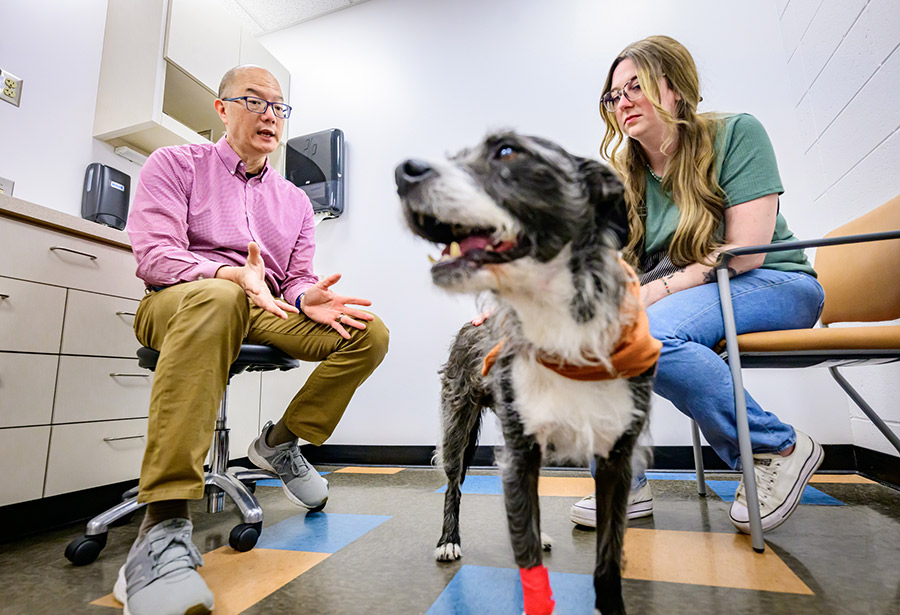Illinois Veterinarians: Visit the University of Illinois Veterinary Diagnostic Laboratory website for recommendations for submitting samples in suspect canine respiratory cases.
General Information
Lisa Bazzle, DVM, DACVECC, who heads the small animal emergency service at the University of Illinois Veterinary Teaching Hospital, prepared the brief overview below about the mysterious respiratory illness in dogs that has received much attention in the media recently.
As of November 21, our clinicians at the Veterinary Teaching Hospital in Urbana and the Medical District Veterinary Clinic in Chicago had not seen an uptick in canine respiratory cases. The illness currently in the news has been reported in the northeast, southeast, Pacific northwest, and Colorado.
The symptoms mimic those of kennel cough or canine infectious respiratory disease complex (CIRDC), as respiratory signs including coughing, sneezing, eye and nose discharge, lethargy, decreased appetite, and fever may be evident.
While the exact mode of disease transmission remains unknown, since respiratory signs predominate and cases have been shown to spread quickly among dogs in a communal environment, direct and indirect contact (via spread of respiratory droplets in the air and on shared surfaces) are the presumed main drivers of transmission. Unlike the more common infections associated with kennel cough and CIRDC, these cases don’t respond to standard medical therapy, and can have a prolonged illness that can progress to pneumonia. Of these, some respond to antibiotic therapy, supportive therapy, and oxygen support, while other cases deteriorate rapidly.
Right now, we don’t know the true extent of illness or deaths because we don’t have sufficient data as the symptoms overlap with other causes of lung disease, and the presumed infectious agent (or agents) driving disease remains unknown. At this time, too few positive bacterial and viral samples have been collected nationally to clarify the lung pathology, and what leads some dogs to recover and others to succumb to the disease.
Based on the known modes of disease transmission with respiratory disease, the symptoms, and predominant affected patient population (dogs in close proximity to one another), a viral and/or bacterial agent is presumed. To strengthen our ability to identify the causative agents of disease, early diagnostic testing (including swabs of the throat, airway sampling) is encouraged. Empiric antibiotic therapy may lead to resistance to organisms that need to be identified to better educate us about the disease and mode of transmission, ultimately to help us better treat this disease.
What Do We Know Now about the Respiratory Disease?
- Cases may spread quickly in a communal environment. Respiratory diseases spread through direct dog-to-dog contact and indirectly via respiratory droplets from coughing, sneezing, or contamination of shared surfaces. Therefore, owners of dogs that go to day care, dog training classes, dog parks, shelters, and boarding/grooming facilities should be mindful of the potential for disease transmission in areas where dogs are in close proximity. In addition, owners should remain informed about any cases of respiratory disease in these locations.
- See your veterinarian. If a dog is experiencing respiratory signs, including coughing, sneezing, ocular/nasal discharge, fever, and decreased appetite, we suggest you consult with a veterinarian. Keep your dog isolated from other dogs to minimize the spread, especially as the details of this disease continue to emerge.
- Get your dog vaccinated. Owners should be sure their dogs are up to date with vaccinations, including those that protect against Bordetella, Adenovirus 2, Parainfluenza, and the influenza H3N2 vaccine. Please avoid bringing a dog into the community until the immune system has had time to build immunity (approximately two weeks after vaccination). If owners have immunocompromised dogs (e.g., puppies that are not fully vaccinated and senior dogs with other health problems), they should be cautious about bringing them around other dogs.
- Consider getting diagnostics done early. Because we don’t yet know the cause of the disease, it might be a good idea to get diagnostic testing done when the symptoms first arise, before starting therapy. That’s because once treatment begins and the immune response kicks in, diagnostic tests (e.g., PCR, airway culture, viral isolation) may not be able to detect the virus or bacterium that caused the symptoms.




